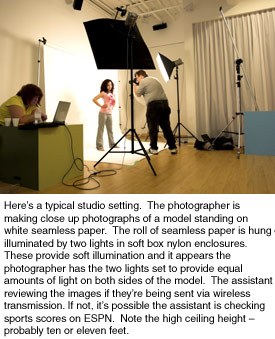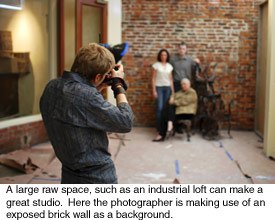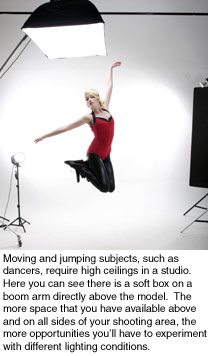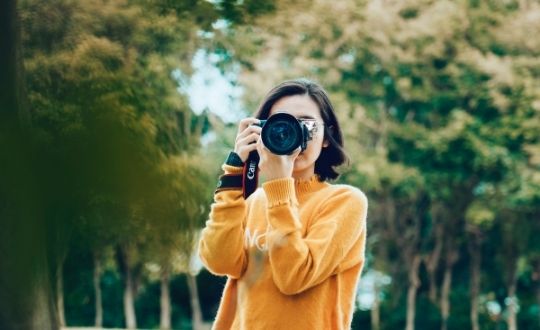You are a highly intelligent individual and you want to be a successful professional photographer or an advanced serious amateur. You've purchased excellent equipment, enrolled in photography's premier correspondence course, NYIP's Complete Course in Professional Photography studied thoroughly, practiced diligently, and now you believe that you need a studio. It's part of your dream, part of your goal, and the absence of a studio makes you feel naked, incomplete, unfulfilled.
Your situation is one that I hear about frequently at NYIP, and I would like to offer you some suggestions that I hope will help you in this major undertaking. I am not going to discuss traditional darkroom layouts nor am I going to analyze the needs you might have in your digital workroom. I am concentrating solely on the area that you want (and need) solely for the making of photographs, for consulting with clients, and for handling your business-related activities.
I used terms in the previous paragraph that you should consider carefully: want and need. You may want a studio and not really need one; you may need a studio and not really want one. If you don't need a studio and don't want one then this discussion is academic, and you can get back to the art, craft, and science of photography.

Suppose that you want a studio so much that you hunger for it. But do you need one? Professionally, if you plan to be a roving street photographer, a budding Cartier-Bresson perhaps, and you never intend to make commercial advertising photographs, table top still life pictures, indoor glamour or fashions shots, etc., then you probably don’t need a studio. You may have the money to build it or can acquire the money but you know you really don’t have to it. So, we urge you to weigh all this carefully and not rush headlong into such a project.
If, on the other hand, you don’t want a studio the nature of your business may dictate otherwise. You may start off doing all your photography outdoors or at various indoor locations. That’s fine, but suppose jobs start coming your way that will surely require the use of studio space. If you live in New York, Los Angeles, Miami, or Chicago there is fully equipped studio space that can be rented. But what do you do if you're in Big Foot, Idaho? So, your business planning must deal with possible future needs as well as current ones.
You don't have to be a professional, of course, to want or need a studio. A serious advanced amateur might also be able to make good use of studio space.
All too often students ask me about studio construction and preface their remarks by telling us ‚I've got this spare space in my basement or attic, etc.‚ And I ask immediately ‚how big?‚ And nearly always the indicated space is much too small.
The space might be adequate for small-object table top photography but not nearly adequate for doing a full length portrait of an individual adult person. Maybe you could make a portrait of a seated person but what if your subject is 6'4‚ and standing? And your studio ceiling is only 8' high?
Remember, too, that ceiling height is not only a consideration for your subjects. Equipment needs must be evaluated as well. Suppose, for example, that you are bouncing your light into an umbrella that has a diameter of 48‚-52‚. As you raise your light stand (and your umbrella) you very likely will find that the top part of the umbrella's circumference hits your relatively low ceiling before your light is at the desired height. You could, of course, use a smaller umbrella but the lighting effect will not be the same as before. Hence, the need or a higher ceiling.
Or suppose your proposed studio space is 10' wide and you have to make a group portrait with ten people in the picture. Even if you put them in two rows you won't have enough room. Suppose that you put them in three rows. Then you may run into problems of having too little depth of field because you may need too large an aperture?
Or suppose your intended studio space is only 12' deep. You've got to allow space from the subject to the background, space from the camera to the subject, space for your lights, and space for you, the photographer, to move about.
Suppose that you have minimal space for your shooting needs. If you're a professional portrait photographer you're going to need a reception area that is decidedly separate from your shooting area.
And in the studio proper you'll need storage space for equipment. too. And a dressing room and lavatory as well.

Am I suggesting studios the size of airplane hangars or barns? Not really, but I am suggesting that there is no substitute for space in a photo studio. In other words, a room that is tall enough, wide enough, and deep enough for your actual needs. It also must be a room that can be isolated from all other rooms so that you can function without interference from family members, and so forth.
Let me give you an actual inquiry about a studio that I received some years ago at NYI.
The student told me that he wanted to open a portrait studio and that he needed to make a choice between one in his home and one in a new shopping mall whose spaces were beginning to be available for rent. I asked how far was his home from the mall. ‚Oh, about five miles‚, he said. So I had to point out, tactfully, some facts that should have been obvious to him when planning a studio.
Why a studio in the home? Well, he said that it was much cheaper than at the mall. I couldn't dispute that but what difference did it make? I then asked him why did he think that the builders of the mall had chosen the location that they did. I pointed out that they had spent millions of dollars on the project but only after doing substantial research about the demographics of the area, traffic patterns, population growth, etc.
So I put the next question to him. Didn't he think that prospective clients would more likely head in the direction of the new shopping mall rather than drive five miles in the opposite direction. He agreed, and so I asked what if a studio in his home was cheaper? What did it matter if no one came to his house but people were jam packing the parking lot at the mall? Even if his house might have physically had the space for a nice studio?
So much for the decision to rent space at the mall. But he called me a few days later with another problem, namely, what to do about a lavatory. He knew that installing a lavatory is expensive but that the corridor in the mall had one at the end and could that be used. So I asked him would his portrait subject want to traipse down to the end of the corridor to use the facilities. What if the subject was a bride in her wedding gown, having a formal bridal portrait made? Or some similar situation? It didn't take long to convince him that renting space in the mall, building a lavatory on his rented premises, and so forth was a better idea than trying to set up a studio in his home five miles away from the mainstream of traffic.

Surely there are private homes where excellent studios can be constructed. In big old Victorian houses where there is ample space. In refurbished lofts, in some spacious very modern houses. But there are many other houses where the needs for a good photo studio simply cannot be met. At the risk of shattering the would- be portrait photographer's dream let me suggest that the prospective plans be carefully scrutinized.
And there is another point. If you need to borrow money from some lending institution, bank, finance company, or what-have you, you're probably going to be required to present a business plan that will clearly indicate how you are going to pay back the borrowed money. Studio planning will be a vital part of that business plan!
I have not written anything here about photographic equipment, deliberately. All too often the aspiring studio photographer thinks first about equipment when he or she should be paying more attention to space. If the photographer's budget is limited (all too frequently the case) space considerations should be evaluated before photographic hardware. The work area for the studio can be very costly and careful planning is necessary.
Well, now that I may have totally shattered your dream for your own studio let me give you some consolation.
Have you ever considered time sharing as a feasible alternative to owning your own studio? Not as attractive as having your own ‚digs‚ but possible. You might find another photographer or two, not competitors and doing work much different than yours. Unless you are enormously busy you will not need your studio all the time. If you shared space with other photographers (and shared time as well) you might be able to have a studio of adequate space and in the right location. Doctors and dentists do time-and-space-and cost sharing. Lawyers do it. Here in New York diamond dealers share space and may have as many as forty different dealers all in the same space and not connected to each other in a business way.
But I mentioned that if you share time and space with other photographers you should look for those doing work different from yours. You don't want another wedding photographer competing with you at the same location, but suppose that the other photographer does table top still life photographs. Or concentrates on legal document photography for licenses, passports, and so forth. Time sharing details require careful planning and certainly need a contractual agreement between the various parties, but all this can be worked out and you will have a studio!
When you are beginning and cannot afford a proper studio you might start with location portraits. And I don't meandoor-to-door –portraits with a pony on which to photograph the children (or equine-inclined adults). You'll still have the usual overhead expenses but you will be spared the expense of a big studio. You will need a small office to conduct your business but no large shooting area.
And there is a plus with location portraiture. Your name and your work may become household words so that when you do open your studio people will already know about you and respect your work. A good location portrait business may ver well lead to something larger and more elaborate, something truly indicative of your skill and artistry.






